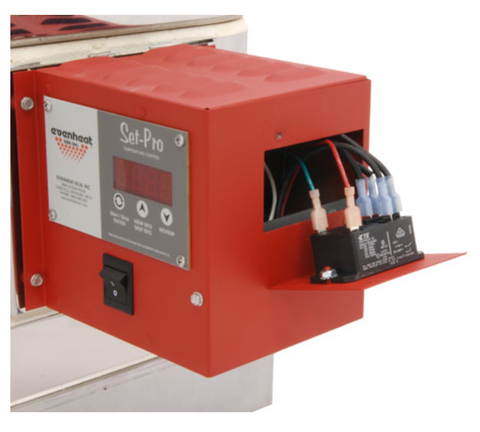Understanding Kiln Relays: For New Kiln Buyers and Owners
Ah, the timeless query of kiln shopping: "Which kiln relays should I go for?" It's like asking a chef for their salt preference – important, but let's not get too salty about it. Kiln relays are like the Elon Musk of the kiln world – well-known but often misunderstood. If you're scratching your head wondering about relays, don't fret. This article will shed light on the topic, enlighten you, and make you wonder how you ever survived without this knowledge.
Your kiln's relays are the VIPs of the whole kiln operation. Treat them right, and they'll keep your artistic dreams alive. Neglect them, and you'll end up with a sad, cold kiln. So, let's grasp the basics of relays, so we can discuss relay care and maintenance.
What are kiln relays, and how do they work?
Relays act as gatekeepers, regulating the electric current in a kiln. When a relay is closed, it allows energy to flow to the kiln's heating elements, making them hotter. Conversely, when the relay is open, the circuit is interrupted, and no electricity reaches the coils, resulting in no heat. Larger kilns are equipped with multiple relays, each controlling a specific area.
Imagine relays as bouncers at a nightclub. They ensure things don't get too hot with an overcrowded club. They let in just enough people to heat up the action, then close the door to maintain the perfect temperature. When things cool down, the relay receives the signal to allow more people onto the dance floor (the element), restarting the cycle. That clicking sound your kiln makes during firing? It's the mechanical relays cycling on and off, akin to a bouncer opening and closing the club door to maintain the desired temperature.
What are the different types of kiln relays, and how do they differ in function and longevity?
Just imagine you're cruising down the highway, wind in your hair, not a care in the world because you never have to change your car's tires! No more struggling with lug nuts or getting your hands dirty. Ah, the relaxing feeling of never having to deal with a flat tire or the dreaded tire store. It's like winning the lottery, but without the money or the fame. Mercury and solid-state relays are kind of like that, they're the choose-it and forget-it component of your kiln that you'll never be sorry you chose. Mechanical relays are like the candles on a birthday cake - they have a limited lifespan and eventually need to be replaced. They'll last you about as long as a Kardashian marriage, so make sure to cherish every click.
There are three main types of kiln relays:
|
1. Mercury relays: These use a tube of mercury with an internal weight that determines whether the mercury rises to complete the electrical contact. With fewer moving parts, mercury relays have an impressively long functional life, typically lasting around 5 million cycles. They are nearly indestructible, but due to mercury disposal concerns, some states no longer allow their use. |
 |
|
2. Solid-State relays: Operating with power semiconductor devices, solid-state relays have no moving parts. They control the flow of electricity by opening and closing. Due to their lack of moving parts, these relays boast an exceptionally long functional life, said to surpass 1000 years! They offer tighter temperature controls because they cycle faster, which is also said to save energy. |

|
|
3. Mechanical relays: These relays utilize electric current to move a contact, either opening or closing the circuit using an electromagnetic switch. Mechanical relays do have moving parts and because of that they have a limited lifespan. On average, they last around 200,000 cycles (clicks), which translates to approximately 18-36 months, depending on usage, firing temperatures, and schedules. |

|
Why is it crucial to monitor the health of kiln relays?
Imagine if your trusty relay suddenly called it quits. It's either going to be a hot mess or a complete blackout. If the relay stays open, you'll be left with a cold and useless kiln – no heat for you! On the other hand, if it fails in the closed position, get ready for an intense blast of unending heat. Neglecting to monitor your mechanical relays can turn your project into a disaster, leading to kiln meltdowns or accidental kiln damage. While larger kilns with multiple relays offer some backup, you'll still sense that something has gone awry.
When should you replace your kiln Relays?
Now, let's address the million-dollar question: When should you replace your kiln relays? Well, imagine your relays belting out Whitney Houston's "I Will Always Love You." That's your cue to bid them farewell! The lifespan of your relays depends on their type. If you have mercury or solid-state relays, consider them ageless wonders that can last the entire lifespan of your kiln, just like Rob Lowe's ever-youthful career or the timeless elegance of Jane Fonda, or even Cher. They just don't age! A periodic visual inspection should suffice to ensure their good health.
However, if you're rocking mechanical relays, it's a different story. These relays have moving parts, which means they eventually wear out like a neglected houseplant. On average, you can expect them to last around 18 to 36 months. Of course, usage, firing temperatures, and firing schedules play a role, so it's best to replace them every 18-24 months as a precautionary measure.
Luckily, some kiln manufacturers have added nifty features to make relay monitoring easier.
 |
Jen-Ken Kilns has installed a "pilot light" on every relay of every model. It's like having your own personal relay detective! If the light stays dark when the relay fires, you know there's a problem with the element, relay, or connection. |
 |
Evenheat Kilns introduced a relay access door, a secret passage to a world of wires and switches. It's a magical portal that saves your fingers from untangling wires like a hopeless spaghetti chef. |
When it's time to replace a relay:
- Be sure to check for heat damage on the old relay.
- Look for melted spots in the plastic body, indicating excessive heat. In such cases, replace the push-on terminal of the wire connected to the relay before installing the new one.
- Loose terminals can wreak havoc on the new relay, as they generate excessive heat and compromise performance.
Remember, a well-maintained kiln with healthy relays will keep your creative projects on track. So, embrace the kiln relay journey, have some fun with it, and keep those artistic dreams alive.
And hey, who knew kiln relays could be so entertaining? Now go forth and conquer the world of kiln-firing with your newfound relay knowledge!
For more information on kiln relays and replacing them, check out these resources from our trusted manufacturers:
Evenheat Kilns: Relay Replacement via Access Port Showcase
Paragon Kilns: Relay Replacement Guide and YouTube video.
Olympic Kilns: Relay Replacement Guide
Jen-Ken Kilns: Small Relay and Large Relay
So, there you have it! Kiln relays may seem like hidden heroes, but they play a vital role in the success of your creations. Understanding their purpose, types, and lifespan is key to maintaining a well-functioning kiln. Remember to regularly inspect your relays, replace them when necessary, and keep an eye out for any signs of heat damage.
Now, armed with this newfound knowledge, you can confidently embark on your kiln-firing adventures. Whether you're a seasoned artist or just starting out, the dance between you and your kiln relays will be one of artistry, precision, and, most importantly, creativity.
So, turn up the heat, let the kiln roar, and let your imagination run wild as you create beautiful ceramic pieces with the assistance of your trusty kiln relays. Happy firing!
Need to order replacement relays? This form can help!
Or if you know what you need, here is a link to order mechanical relays
If you have any more questions or need further assistance, feel free to ask. You can talk to a real person on the phone immediately (361-596-3764), or via instant chat (click here to start a chat now), email (customerservice@kilnfrog.com) or via real time texting (361-596-3764) - you choose! (We promise we will respond during regular business hours.) Enjoy your artistic journey!







Leave a comment